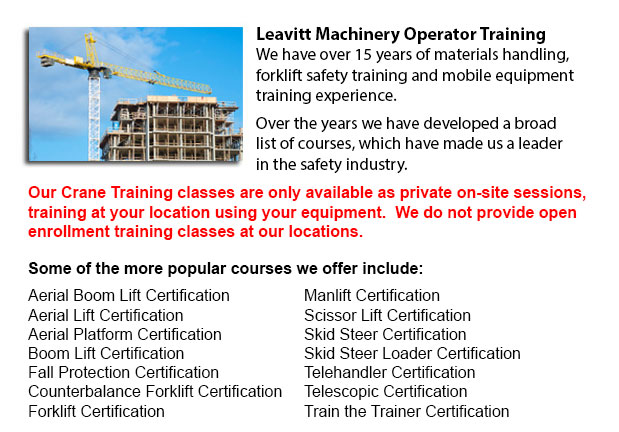
Coquitlam Overhead Crane Operator Training - The course teaching overhead crane operator training has been designed specially to instruct trainees on the basics of pre-shift inspections and overhead crane/sling operation. The programs are instructed by professional trainers and consultants. Well-trained staff are more efficient and productive, that saves on expenses associated with merchandise damage, property damage, and accidents because of the utilization of incorrect operating measures. Our overhead crane certification is customized for staff who have literacy barriers, reducing certification time by 50 percent.
The overhead crane has been made to be utilizing doing repetitive hoisting activities. This particular kind of crane could be used in numerous capacities. They could be used for specialized lifting tasks like removing or installing major plant machinery.
In order to safely make use of an overhead crane, workers should employ safe rigging practices. This requires both knowledge and practice. The load should be rigged correctly to be able to guarantee its stability when raised. Prior to starting a lifting job, it should be determined that the crane is right for the task, with appropriate capacity, travel and lift. The crane needs to be subjected to a thorough visual and physical check before use. The capacity of all machines, including the slings, hardware and rope, should never exceed load weight capacities.
Before utilizing the rigger should know what sling is right for each lift and must check the rigging hardware and gear. The communications which are utilized with the crane operator need to be concise and clear. A signaler should be chosen for the role and signals should be agreed upon. The crane operator must follow instructions just from the chosen individual. If a wired or remote controller is being utilized, the operator must be trained in all its functions.
To be able to ensure the safety of staff, a warning needs to be issued and the path of the load must be cleared of all obstructions before the lift starts. People should not be allowed to walk below the lift loads. The crane hoist should be centered over the load before lifting to prevent swinging. The safety catch should be closed instantly after sliding the sling fully onto the lifting hook. Unused sling legs should be secured so they do not drag. Never leave loose materials on a load being hoisted. Watch that hands and fingers are clear when slack is taken out of a sling. Before the lift is carried out, step clear of the danger zone.
-
Coquitlam Crane Certification
Coquitlam Crane Certification - The Crane Certification training program consists of subject matter recommended by industry concerning the safe and efficient operation of cranes. Trainees will be taught the following: how to identify cranes and their... More -
Coquitlam Crane Training Courses
Coquitlam Crane Training Courses - A crane is a kind of equipment designed to move, lift and lower heavy stuff. A crane is usually equipped with a hoist, sheaves, and chains or wire ropes. Cranes are used in the manufacturing, construction and transp... More -
Coquitlam Boom Lift Safety Training
Coquitlam Boom Lift Safey Training - Boom lifts are a kind of elevated work platform or aerial lifting device which are usually used in industry, warehousing and construction. Boom lifts can be utilized in virtually any setting due to their versatili... More -
Coquitlam Boom Lift Training
Coquitlam Boom Lift Training - Aerial platforms or also known as elevated work platforms are devices which allow workers to carry out duties and tasks at elevated heights that would not be otherwise reachable. There are different aerial lifts availab... More -
Coquitlam Forklift Certification Schools
Coquitlam Forklift Certification Schools - Forklift Certification is mandatory within North America. Hence, forklift training programs are important both for businesses and for people looking for jobs in industries as operators of forklifts. Forklift... More -
Coquitlam Wheel Loader Training
Coquitlam Wheel Loader Training - Normally, the different types of heavy equipment training are divided into 2 categories of equipment: those that have rubber tires and tracked vehicles. Tracked vehicles include items like for instance bulldozers, ex... More -
Coquitlam Heavy Equipment Training Schools
Coquitlam Heavy Equipment Training Schools - There are a lot of heavy equipment training schools to choose from. If you would like to get to the best, it is important to examine several factors of the school to be able to determine the level of educa... More -
Coquitlam Telehandler Training Courses
Coquitlam Telehandler Training Courses - Employers are responsible for making sure that their supervisory and operating personnel are trained to work proficiently making use of telehandler equipment. The skill level of workers should be assessed. If... More

Forklift Certification Coquitlam
TOLL FREE: 1-888-254-6157
Coquitlam, British Columbia
forkliftcertificationcoquitlam.com
Email Us
About Us


